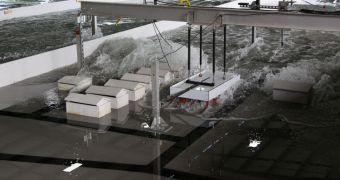As reported earlier, the Cascadia subduction zone in the Pacific Northwest is about to experience a major earthquake. Experts have calculated that the area has a 33 percent chance of suffering the effects of a large tremor within the next 50 years. In immediate response to this new study, a small coastal community in Oregon now plans to design and build a structure that is unprecedented in the United States – a defense mechanism against earthquakes and tsunamis that will give people a fighting chance in the event of a natural disaster.
The thing about major earthquakes in this region is that, if they take place offshore, they can generate very large tsunami waves. The proximity of the fault line system to the coastlines means that residents in the “blast area” will only get a maximum of 15 minutes of forewarning, before the water hits. While this may be insufficient to allow for a complete evacuation, it could be enough for many to make their way to the newly-proposed defenses. The concept underlying the entire endeavor is “vertical evacuation,” and in this case it refers to a sturdy, sufficiently-tall building.
“We're heading in the right direction, but this is new territory. There's a lot we still need to learn about the impact of forces from waves, cars, collapsed buildings and other debris, and just how strong a building must be to resist that. But our tests should help add a higher degree of confidence in this design,” explains Oregon State University professor of coastal and ocean engineering, Dan Cox. The work was demanded by the small town of Cannon Beach, and university researchers are working together with scientists from the Oregon Department of Geology and Mineral Industry to find a solution. Residents of the town have something very specific in mind.
They want to construct a new structure to act as city hall. The building will have to serve the dual purpose of functioning as an administrative building, but also double as a live-saving tsunami and earthquake shelter, when tectonic activity ensues. Research into this project has already resulted in a 9,800-square-foot structure, and a $4 million price tag. Funding is currently being sought for with the federal government, those involved in the project say.
“Every community from Cape Mendocino in California to Vancouver Island in Canada is vulnerable to some extent to the Cascadia subduction zone earthquake and tsunamis. This is arguably the greatest recurring natural hazard in the lower 48 states. Our cities are not engineered to deal with it and our residents are not prepared for it. We need evacuation routes, assembly sites, public education and outreach. And in some places, we need vertical evacuation structures,” explains OSU Sea Grant Extension hazards outreach specialist Patrick Corcoran.
“In all but the most catastrophic scenarios, it's been estimated that the water level from an incoming tsunami at the site we propose to build the new city hall could be up to 15 feet. We think this building could shelter at least 1,500 people. It will cost more, but so far there has been a pretty positive public reaction to the idea,” concludes Cannon Beach architect Jay Raskin, who is also a part of the efforts.

 14 DAY TRIAL //
14 DAY TRIAL //